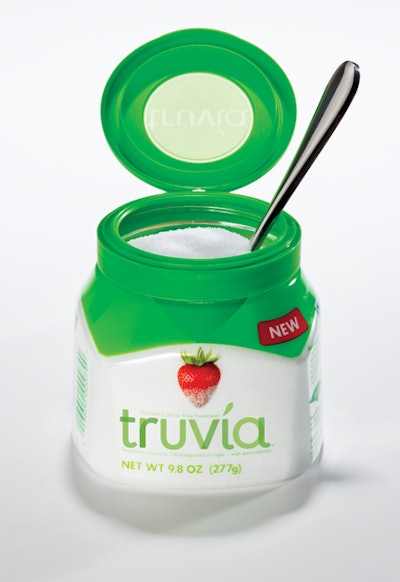The original packaging featured sachets packaged in a unique folding carton designed to remain on the consumer’s table or counter as a convenient dispenser of the packets rather than being relegated to a cabinet. The three-flap carton carries attractive graphics and is designed to open easily and close securely.
This year, Cargill has introduced a spoonable version of the sweetener, also in a container intended to become an addition to the consumer’s table. The company initiated the project based on consumer research and consumers’ desire to easily measure out their sweetness by the spoonful rather than by the sachet..
“As an example of the consumer demand for the product, in one month alone” says Ann Clark Tucker, director of marketing and communications for the Truvia brand, “there were 80 requests from our consumer service center asking that we introduce a spoonable product.”.
The package for the new offering is a square wide-mouth PET jar that is injection stretch blow molded on single-stage equipment by Silgan Plastics. The jar has an attractive, softly-curving shoulder and a flip-top closure from Aptar that allows easy access to the product. Graphics and product information are carried by a full-body PET shrink sleeve label that the consumer can remove after use to create a convenient storage jar. The jar and closure are both molded from recyclable PET.
Developing the container
In June 2009, Cargill’s Truvia management team sent the Silgan Plastics Creative Design Services Group a creative brief consolidating the team’s thoughts about the new package into some general design guidelines.
“Our objective,” says Tucker, “was to present our thinking and to guide the design team in developing prototype concepts.”
The brief stated that the new package was to be a bulk container carrying the equivalent of 80 packets of Truvia natural sweetener. It was to be a recyclable rigid container that would be clear, colored, or translucent depending on the material, and designed to allow consumers to conveniently dip, spoon, or sprinkle Truvia natural sweetener into coffee or tea and onto fruit or cereal in quantities of their choosing, or to include it in recipes. As part of the greater goal of changing consumer behavior with sweeteners, the Truvia team also wanted to be sure that the package would fit the average hand and be comfortable for consumers to hold during use.
The new package’s graphics were to replicate the brand image design used on the existing Truvia cartons, but the brief stressed that the package itself should be a unique design distinctive from anything currently on the retail shelf. The Truvia brand also wanted it to be practical for the retailer, so it preferred a basically square design for maximum cube use, as well as stackability, in view of its small size (9.8 ounces), to maximize shelf space for retailers. (As a result, the final jar design has a recessed bottom that matches the closure of the jar below, resulting in stable shelf stacking.) “Our primary objective, as expressed by Zanna Mcferson, assistant vice president for Cargill, the business enterprise leader for Truvia,” points out Tucker, “was ‘to develop a package that would change the way that consumers use a zero calorie sweetener at home’. We wanted the consumer to be able to experiment to find his or her ideal portion that adds the preferred sweetness level for different uses. We also wanted the packaging to be convenient, and sufficiently distinctive and attractive that consumers would be comfortable displaying it on their countertops or tables rather than keeping the sweetener stored in a cabinet.”
Responding to that initial input, the Silgan Plastics marketing group conducted extensive market research, looking at the packaging currently used by various food and other consumer packaged goods categories. At the same time, the Silgan design team researched a wide range of packaging shapes and materials available globally, from paperboard canisters to decorative china and plastic jars.
The design process
Following the research phase, the Silgan Plastics team developed computer-generated designs and ten FDM (fused deposition modeling) models of containers based on their findings. They also assembled a group of sample closures. The Truvia team visited the Silgan Plastics design center in Norcross, GA, where they were able not only to view and handle the various models, but even to spoon Truvia natural sweetener from several of the hollow models. This allowed the team to narrow the design selection to a preferred few, and suggest refinements to those.
“The process,” says Drew Pecore, Cargill’s external manufacturing manager, “covered a period of about 12 weeks of tweaking—a volume change here, a neck finish adjustment there, and a lot of perfecting of the shape of the jar. We wanted the package to be able to make the same dramatic entry into the marketplace that the cartons had made.” In subsequent meetings, the design team presented models of the revised designs, as well as renderings showing full graphics (the FDM models did not include graphics). At each successive meeting, discussions continued to narrow the options available until the final package resulted. For example, though originally open to translucent or opaque packaging, the Truvia team determined early on that the package should be clear, to show off the crystalline form of the product, which distinguishes it from powdered artificial sweeteners.
During the design process, discussions also took place about the design of the closure. Silgan Plastics designers suggested that, in addition to primary package brand image graphics, there should be some subtle branding on the closure, to remind consumers of the Truvia name every time they opened the container. The closure finally chosen by Cargill is a 70-mm Aptar Food + Beverage stock Camelia bi-injected flip-top dispensing closure. Aptar customized the closure to the Truvia brand’s specific needs by altering the mold to incorporate a translucent window in the closure top, decorated with a subtly molded Truvia logo.
Creating the shrink sleeve label
The Truvia brief to Silgan Plastics had originally suggested a simple pressure-sensitive label for the container. But the final decision was to use a shrink sleeve label that could effectively project attractive brand image graphics while leaving large clear areas for the consumer to see the crystalline product.
“Consumers can easily remove the sleeve when the jar is empty, if they wish,” says Tucker, “to make it more suitable for in-home storage use. As Silgan Plastics had suggested, however, the subtle branding on the closure will remain.”
The sleeve was designed by Cargill’s advertising agency, Ogilvy Chicago. American Fuji Seal prints the sleeve using 10-color rotogravure process on 50-micron (2 mil) PET film, selected both for its shrink capabilities and its scuff resistance.
The Truvia jars are molded at the Silgan Plastics facility in Penn Yan, NY, and shipped to the company’s facility in Ligonier, Indiana, where the shrink sleeve label is applied using Fuji Seal Inter Sleeve equipment. The closures are bi-injection-molded of polypropylene at Aptar’s Mukwonago, Wisconsin plant. Bi-injection-molding allows Aptar to meet Cargill’s request that the closure be opaque around the closure body itself but have a see-through area on top. Made with what Aptar calls a “biased” hinge so that it will spring open and shut, the closure is also fitted with a liner that will later be induction-sealed to the jar after filling. Closure, product, and labeled containers all come together at Power Packaging in St. Charles, Illinois, where the package is filled, sealed, and case packed for distribution.
“Retailers have responded very well to the new packaging,” says Cargill’s Tucker. “From the beginning, retailers began contacting us and asking how quickly we could supply them. And they have been shelving it as an incremental Truvia SKU, not using it to replace another size packaging.”
Truvia natural sweetener has grown to be the third most popular sweetener in the U.S. market. Globally, France has given regulatory approval to stevia-based sweeteners ahead of other European Union countries, and the Truvia natural sweetener products will be in French stores in the near future. Other EU countries will follow as regulatory approvals are given.
























